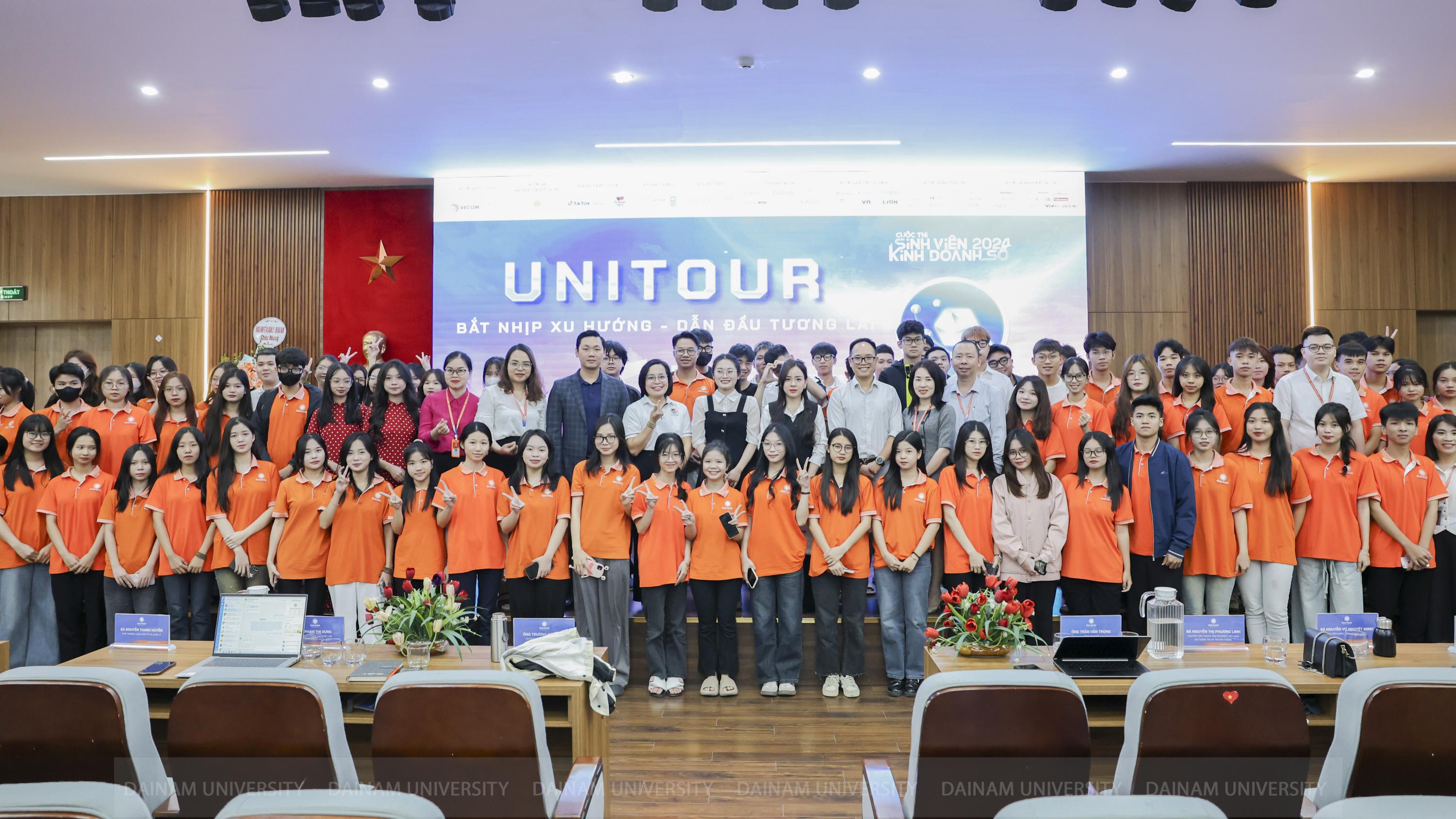Principles in teaching accounting at Dai Nam University
Posted date 04/03/2016
1.941 view

This article introduces “Principles in Teaching” by Ulrich Lipp – German Pedagogical Training Expert and then applies this principle in teaching Accounting at Dai Nam University.
MSc. Le The Anh – Head of Accounting Department
According to the latest report of the Ministry of Labor, War Invalids and Social Affairs, unemployment among workers with a university degree or higher is 162,400 people. Thus, in the first quarter, the number of unemployed workers with a university degree increased by more than 90,000 people, compared to the number of 72,000 people at the end of the fourth quarter of last year. There are many reasons for this unemployment, including the quality of university teaching. Therefore, teaching quality has been and is one of the top concerns of Vietnamese higher education. Universities have also built their own criteria to evaluate output standards, but there is still no common "standard" of what constitutes good teaching to guide teaching activities. What principles need to be followed to have a successful lecture, promoting the capacity and creativity of learners? This article introduces “Principles in Teaching” by Ulrich Lipp – German Pedagogical Training Expert and then applies this principle in teaching Accounting at Dai Nam University.
Accounting teaching content includes related issues such as vouchers, accounts, provisions, books and reports in a dry way. To make it softer and more attractive, lecturers need to continuously learn, research and maintain a high level of understanding of teaching content, ensuring that the subject content is always updated, accurate, representative and suitable for reality. To achieve teaching content competence, lecturers must proactively update the content areas related to the courses they teach and must comply with the following teaching principles:
1. Principle: Real-life contact
“Good teaching begins with practice and ends with practice” - Ulrich Lipp
The content we teach in class must be related to the outside life, past, present and future of the learner. Survey results of older people, they will not want to learn if the content is not related to the work they are doing.
So how did we relate this to reality in the lecture?
Giving examples related to the learner's daily work is a good way to open the lesson. This example makes the listener curious and realizes that the lesson will be updated to their work, close, useful to them. When the learner clearly sees the benefits of learning, they will absorb the lesson better and study more focused.
Accounting teaching content includes related issues such as vouchers, accounts, provisions, books and reports in a dry way. To make it softer and more attractive, lecturers need to continuously learn, research and maintain a high level of understanding of teaching content, ensuring that the subject content is always updated, accurate, representative and suitable for reality. To achieve teaching content competence, lecturers must proactively update the content areas related to the courses they teach and must comply with the following teaching principles:
1. Principle: Real-life contact
“Good teaching begins with practice and ends with practice” - Ulrich Lipp
The content we teach in class must be related to the outside life, past, present and future of the learner. Survey results of older people, they will not want to learn if the content is not related to the work they are doing.
So how did we relate this to reality in the lecture?
Giving examples related to the learner's daily work is a good way to open the lesson. This example makes the listener curious and realizes that the lesson will be updated to their work, close, useful to them. When the learner clearly sees the benefits of learning, they will absorb the lesson better and study more focused.
Example lesson on accounting documents:  Actual situation of paying electricity bill: Every 10th of every month, the cashier of the electricity branch comes to my house to collect the electricity bill. I was startled to see the bill stating 2 million VND for electricity bill in April 2015. I told the cashier that on average my family only uses 400,000 to 500,000 VND for electricity every month. This month my family still uses the same electrical equipment so I do not pay the above unreasonable amount. After a while of arguing, I decided not to pay. The cashier agreed and asked me to prove the unreasonableness of this electricity bill within 3 days. I am a careful person so I still save the electricity bills and show them to the cashier. The next day, the cashier came to apologize and gave me a bill with 500,000 VND and apologized that the staff had entered the wrong number. Actual situation of paying electricity bill: Every 10th of every month, the cashier of the electricity branch comes to my house to collect the electricity bill. I was startled to see the bill stating 2 million VND for electricity bill in April 2015. I told the cashier that on average my family only uses 400,000 to 500,000 VND for electricity every month. This month my family still uses the same electrical equipment so I do not pay the above unreasonable amount. After a while of arguing, I decided not to pay. The cashier agreed and asked me to prove the unreasonableness of this electricity bill within 3 days. I am a careful person so I still save the electricity bills and show them to the cashier. The next day, the cashier came to apologize and gave me a bill with 500,000 VND and apologized that the staff had entered the wrong number. |
Through that favorable start, the learner has an image and usefulness of the document, the teacher can present theoretical parts such as concepts, explanations, rules... By the end of the lesson, the teacher needs to re-establish the connection between the lesson and the learner's reality.
We often say: “learning goes hand in hand with practice” as a slogan without fully understanding what that lesson should be like. So the lesson must start with practice and end with practice to ensure that learning goes hand in hand with practice.
A good, effective lecture should open up and engage learners with questions related to their actual work, thereby providing them with new theoretical knowledge and ending with very practical requirements.
To have time for practical contact, the lecture content needs to be reduced and only focus on the really necessary content. In reality, up to now, we have had to convey too much content in class, so each teacher needs to be flexible in selecting what is most useful for the learners.
2. Principle: Create a positive atmosphere during class.
Learning is always seen as a heavy task, it is impossible to learn well. Learning must be a balance between learning and playing, these are two issues that are not contradictory but opposite. When learners find joy in learning, learning also becomes easier. The responsibility of the teacher is to help learners feel that learning is fun !
Different ways to create a positive, fun atmosphere in class:
+ Bring more smiles;
+ Respect and care for learners;
+ Friendly gestures, especially eyes;
+ Flexibly change methods to create liveliness...
3. Principle: Visualization – Presenting content through images.
According to research results, if we only teach by presentation, the amount of knowledge lost is up to 80%.
People learn not only by listening, but also by observing. Therefore, all important content needs to be visualized and during the lesson, the learner must be able to see it for as long as possible.
Visualization is done through teaching aids such as: Boards, pin boards, slide shows, pictures, drawings, etc. Every time a certain content is taught, the teacher keeps it around the classroom so that the knowledge is always displayed in front of the learners.
For example: For images of documents, we can use paper documents or projectors so that students can see them most clearly.

4. Principle: Encourage learners to do it themselves
No one can learn for a long time if they just sit and absorb passively. Encouraging learners means making them active, proactive, and positive. When encouraged, listeners will become active and learn with a refreshing, lively spirit. Otherwise, it is difficult for anyone to concentrate on listening to a lecture for more than 20 minutes.
Teachers can organize active learning in many different ways such as: asking and answering, conveying the content they have just learned to others or doing practice exercises...
| For example: The teacher asked the students to make a 3-copy VAT invoice. The excitement of writing a document for the first time. The joy of the students who wrote it correctly and the meaningful lesson for the students who wrote it incorrectly… |
5. Principle: Conclude the content of the lecture
Concluding the content or anchoring knowledge is an important part of the teaching process so that learners can remember the knowledge they have learned for a long time. Concluding the content can be done in many ways:
+ Allow time for learners to take notes of main ideas;
+ Repeat and emphasize important content;
+ Do homework;
+ Practice;
+ Ask students to repeat…..
+ Take the multiple choice test to check your understanding of the lesson...
Conclude
Theory and practice are as intertwined as day and night. If the lecture only revolves around bookish knowledge and the learner does not see the relationship with real life, it means that the lesson does not meet the requirements. Theoretical knowledge can be memorized by the learner during the test, but when the test is over, that knowledge will disappear. Theory is important for us to understand the world and thereby change the world. But without a connection to reality, theory is useless. Therefore, in addition to constantly consolidating and maintaining theoretical and practical knowledge at a high level, teachers must also thoroughly understand and flexibly apply the above principles to bring inspiration and passion to the learner. Only by doing these things can we train generations of highly specialized students with good professional skills to meet the requirements of employers.
References
1. Saigon Economic Times Online
2. Prof. Dr. Dinh Van Tien - Ulrich Lipp - Handbook of Pedagogical Methods - Ho Chi Minh City Publishing House - 2003.
3. Strategies for Effective Teaching - Internal Circulation Document.
Concluding the content or anchoring knowledge is an important part of the teaching process so that learners can remember the knowledge they have learned for a long time. Concluding the content can be done in many ways:
+ Allow time for learners to take notes of main ideas;
+ Repeat and emphasize important content;
+ Do homework;
+ Practice;
+ Ask students to repeat…..
+ Take the multiple choice test to check your understanding of the lesson...
Conclude
Theory and practice are as intertwined as day and night. If the lecture only revolves around bookish knowledge and the learner does not see the relationship with real life, it means that the lesson does not meet the requirements. Theoretical knowledge can be memorized by the learner during the test, but when the test is over, that knowledge will disappear. Theory is important for us to understand the world and thereby change the world. But without a connection to reality, theory is useless. Therefore, in addition to constantly consolidating and maintaining theoretical and practical knowledge at a high level, teachers must also thoroughly understand and flexibly apply the above principles to bring inspiration and passion to the learner. Only by doing these things can we train generations of highly specialized students with good professional skills to meet the requirements of employers.
References
1. Saigon Economic Times Online
2. Prof. Dr. Dinh Van Tien - Ulrich Lipp - Handbook of Pedagogical Methods - Ho Chi Minh City Publishing House - 2003.
3. Strategies for Effective Teaching - Internal Circulation Document.
Latest article
View all Posts
Related articles
See all related Articles
Register for admission consultation 2025
Dai Nam University offers admissions to
36 academic programs
across a diverse range of disciplines, including Healthcare, Engineering and Technology, Economics and Business, and Social Sciences and Humanities.
Register now to secure
scholarships and tuition support worth up to 55 billion VND
scholarships and tuition support worth up to 55 billion VND

Register now to secure
scholarships and tuition support worth up to 55 billion VND
scholarships and tuition support worth up to 55 billion VND









